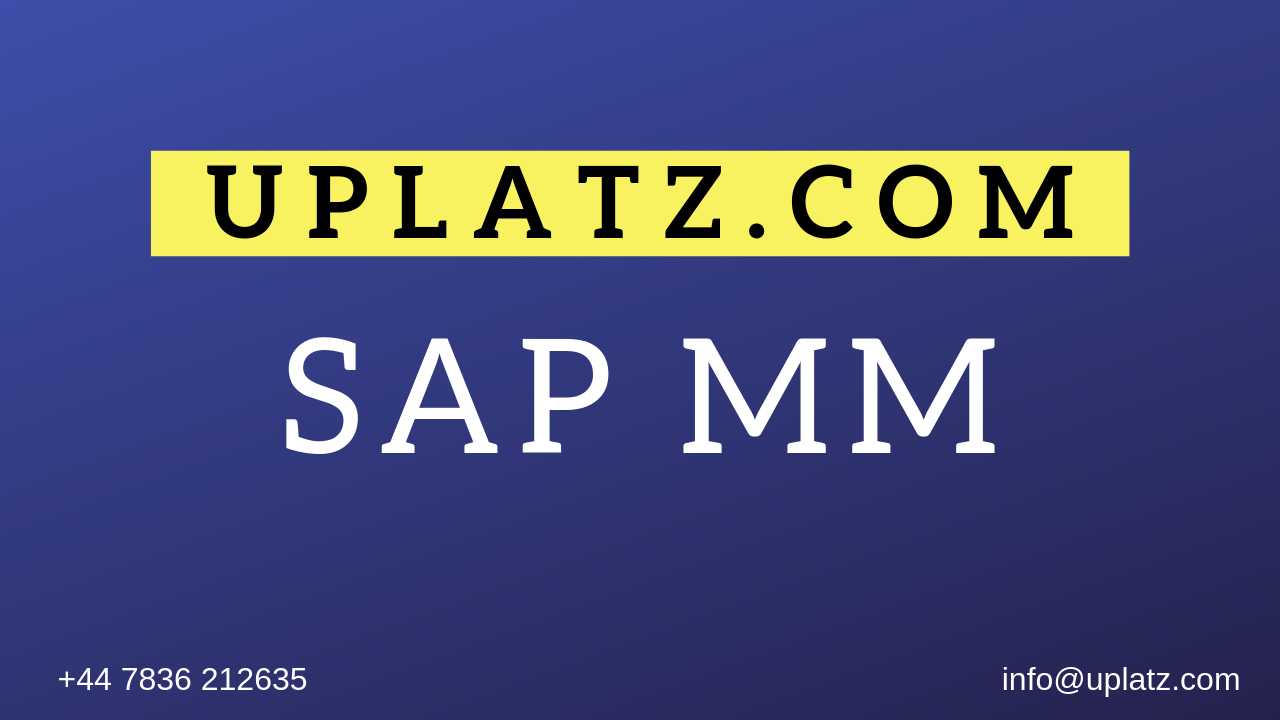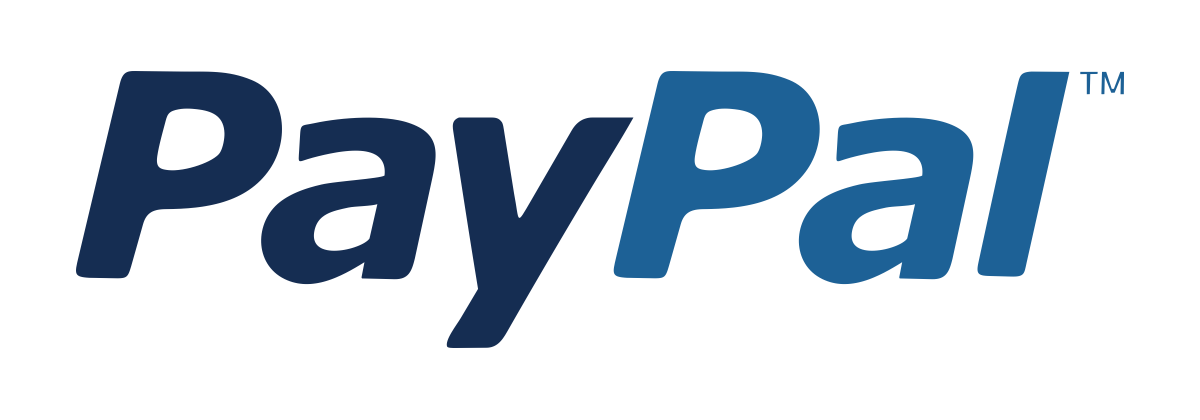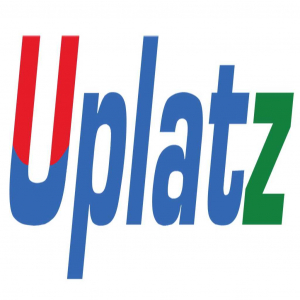SAP MM Training

SAP MM (Material Management) is a module of the SAP Enterprise Resource Planning (ERP) package that is used for Procurement Handling and Management. SAP MM is a material management tool that can help automate and streamline corporate Procurement Handling and Inventory Management (in other words it is about managing resources). Materials management is well integrated with other modules such as SD, PP and QM.
SAP Materials Management (SAP MM) is one of the most important SAP functional modules that deals with management of material and inventory that helps to run any business operation smoothly. SAP MM module also supports other logistic functions where material and inventory information is required. SAP MM plays vital role in speeding up the procurement and material management activities as well as to run business operations.
Uplatz offers comprehensive SAP MM Training course with focus on imparting world-class quality. This course will equip you with knowledge and hands-on practical business scenarios. SAP MM course will also prepare you for the job market as well as for SAP MM certification. Our SAP MM training course is delivered by highly experienced and expert tutors. We will also provide you SAP MM training material, tutor notes, all sessions video recordings, free server access, and a lot more.
If you are looking for the SAP MM online training provider, Uplatz is one of the most reputed SAP online training providers in the market. All our SAP courses have been designed by experts and can help you learn the SAP modules from basics to advanced level. The SAP MM syllabus focuses on practical and project sessions along with comprehensive explanation of concepts. MM trainers will help the students to work on SAP Materials Management software and learn the functions and configuration involved in management of material and inventories of any organisation. Our aim is to provide high class SAP MM online training that will not only help you in the practical learning of major business processes of SAP MM but also to equip you with the knowledge to qualify in SAP MM certification exam.
--------------------------------------------------------------------------------------------------
Who is the target audience?
Anybody who is interested to learn SAP MM People with Retail Experience, people looking to build a career in Retail Industry. SAP MM online training & certification program can be learned by working professionals/SAP functional Consultant or Any interested Graduate who have computer literacy.
--------------------------------------------------------------------------------------------------
What will you learn in SAP MM course?
· Prepare you to take SAP MM certification Exam
· Provide you the knowledge of SAP MM end-to-end transaction in a business process
· You will be able to perform configuration and do implementation on SAP MM
· You will learn about Introduction to ERP & SAP, Master date, Inventory management, purchasing, Invoicing etc.
· You will be able to do integration of SAP with FICO and PP
--------------------------------------------------------------------------------------------------
SAP MM Training
1. Introduction to ERP
· ERP Definition
· Characteristics of ERP
· Products of ERP
· Benefits of using ERP
2. Introduction to SAP
· SAP History
· SAP Product line
· New Products of SAP
· Relation of New SAP Products with the core product
· Industry specific Products
· Type of SAP Projects
· Type of SAP Roles
· Architecture of SAP
· System Landscape
· Types of data used in the SAP system
3. Initial Screens
· How to login to the SAP system
· SAP Client / GUI
· SAP Session - What it is
· How to open a new Session
· Create new Sessions
· Navigation between Sessions
· Transactions and Activities
· Shortcuts or Transaction Codes
· SAP Easy Access screen
· SAP IMG screen
· Difference between Easy Access and IMG screens
4. Enterprise Structure
· What is Enterprise Structure
· The different types of Enterprise Structure
· Company structure in real time
· Company structure for each process
· MM Structure against other process structure
· Enterprise Structure terms in real time against those used in the SAP system
· Definitions of the elements of enterprise structure
· Creation of Enterprise Structure elements in the SAP system
a) Group
b) Company
c) Plant
d) Store
e) Purchasing Department
f) Valuation Area
g) Controlling Area
h) Assignment of the Enterprise Structure elements in the SAP system
o Assign Company to Group
o Assign Plant to Company
o Assign Store to Plant
o Assign Purchasing Departments
o Assign Controlling Area
5. Master Data
· Basics of Master Data
· Significance of Master Data
· Usage of Master Data
· Material Master
· What is Material Master
· Views
· Subscreens
· Fields
· Maintenance of material data in the SAP system
· Prerequisites for creation of Material Master Record
· Creation of Material Master Record
· Changes to Material Master Record
· Other end user activities in Material Master
· Configuration of Material Master
· Screen Sequence
a) What is Screen Sequence
b) Significance and usage of Screen Sequence
· Screen Reference
a) What is Screen Reference
b) Creating and using Screen Reference
· Field Selection
a) What is Field Selection
b) Criteria for defining field selection
· Field Reference
a) What is Field reference
b) Creating and using field references
· Material Type
a) What is Material Type
b) Usage of Material Type in the SAP system
c) Defining and using Material Types
d) Assign Number Range to Material Type
· Material Number formatting
· Material Groups
· Purchasing Group
· Purchase Value Key
· Shipping Instruction
· Vendor Master
a) Who is a Vendor?
b) What is Vendor Master Record
c) Division of Vendor Master data
· General Data
· Company Code Data
· Purchasing Data
· Vendor Classification
· Types of Vendor
a) Regular Vendor
b) One-time Vendor
c) Accounting Vendor
d) Purchasing Vendor
e) Central Vendor
· Prerequisites for creating Vendor Master Record
· Vendor Account Group and its significance
· Creation of Vendor Master Record
· Changing the Vendor Master Record
· Other End user activities of Vendor Master
· Configuration of Vendor Master
· Vendor Field Selection
a) What is Vendor field selection?
b) Significance of vendor field selection
c) Criteria for maintaining vendor field selection
· Assignment of Number Ranges
· Screen selection for Vendor Master records
· Vendor Industries
· Terms of Payment
· Purchasing Info Record
a) Basics of Purchasing Info Record
b) What is Purchasing Info Record
c) Significance of Purchasing Info Record
d) Types of Purchasing Info Record
e) Prerequisites for Purchasing Info Record
f) Creation of Purchasing Info Record
g) Changing the Purchasing Info Record
h) Other End User activities for Purchasing Info Record
i) Configuration
j) Defining Number Ranges for Purchasing Info Record
k) Screen Selection for Purchasing Info Record
· Source Determination
a) Basics of Source Determination
b) What is Source Determination
c) Source Determination options in the SAP system
· Source List
a) Basics of Source List
b) What is Source List
c) Significance and usage of Source List
d) Creation of Source List
e) Changing the Source List
f) Other End User activities for Source List
· Configuration
· Quota Arrangement
a) Basics of Quota Arrangement
b) What is Quota Arrangement
c) Significance and usage of Quota Arrangement
d) Prerequisites for creating Quota Arrangement
e) Creation of Quota Arrangement
f) Changing the Quota Arrangement
g) Other End User activities of Quota Arrangement
· Configuration
6. Purchasing
· Basics of Purchasing
· What is Purchasing
· Difference Between Purchasing and Procurement
· Purchasing Cycle
· Purchasing Documents
· Different types of Purchasing documents used
· Division of Purchasing Document in the SAP system
· Type of data maintained in each division of the purchase document
· Purchase Requisition
a) Basics of Purchase Requisition
b) Creation of Purchase Requisition
c) Other End User activities of Purchase Requisition
· Request for Quotation (RFQ)
a) Basics of RFQ
b) Creation of RFQ
c) Other End User activities of RFQ
· Quotation
a) Basics of Quotation
b) Creation of Quotation
c) Other End User activities of Quotation
· Comparison
a) What is comparison
b) Criteria for comparison in the real time and in the SAP system
c) The comparison process
· Purchase Order
a) What is a Purchase Order
b) Creation of Purchase Order with reference
c) Creation of Purchase Order without reference
· Release Procedure
a) Basics of Release Procedure
b) Release Procedure and Approval process
c) Release Characteristics
d) Release Classes
e) Release Groups
f) Release Codes
g) Release Indicators
h) Release Strategies
i) Releasing the Purchase Order through Release Procedure
· Optimization of Purchasing
a) Concepts of Purchase Optimization
b) Prerequisites for creating a Purchase Order automatically
c) Creation of Purchase Order automatically
· Outline Agreements
a) Basics
b) Contracts
c) Concepts
· Quantity Contract
· Value Contract
· Creation of a Contract
· Other End User activities of Contract
· Scheduling Agreements
a) Concepts
b) Creation of Scheduling Agreement
c) Other End User activities of Scheduling Agreement
· Creation of Delivery Schedule
· Configuration of Purchasing
· Document Types configuration
· Assigning Number Ranges to Document Types
· Screen Selection for the Document Types
· Text Types and Copying Rules
· Tolerances for Archiving documents
7. Inventory Management
· Basics of Inventory Management
· Stock Types
· Movement Types
· Process of Goods Receipt
· Process of Goods Issue
· Stock Transfers
· What is Stock Transfer
· Types of Stock Transfer
· Transfer between Plants
· Transfer between Storage Locations
· Transfer between Stock types
· Transfer using Stock Transport Order
· Return to vendor
· Conditions under material returned to vendor
· Prerequisites for return to vendor
· Cancellation
· Initial Stock
· Reservations
· Physical Inventory
· Configuration
· Plant Parameters
· Number Range assignment
· Screen Selection
· End User Restrictions for Inventory Management activities
· Movement Types and its attributes
· Individual transaction configuration
8. Special Procurement Process / Special Stocks
· Basics of Special Procurement Process / Special Stocks
· Subcontracting
a) What is the Subcontracting process?
b) Where used
c) Steps defining the subcontracting process
d) Configuration for subcontract process
· Consignment
a) What is the Consignment process?
b) Where used
c) Steps defining the Consignment process
d) Configuration for Consignment process
· Pipeline
a) What is the Pipeline process
b) Where used
c) Steps defining the Pipeline process
d) Configuration for Consignment process
9. External Services Management
· Basics of External Services Management
· Service Master
· Service Conditions
· Service Purchase Order
· Service Entry Sheet
· Configuration of External Services Management
10. Valuation and Account Determination
· Valuation Types
· Split Valuation
· What is Split Valuation
· Usage and Significance of Split Valuation
· Global Types
· Global Categories
· Assignment
11. Logistics Invoice Verification
· Concepts
· Planned Costs
· Unplanned Costs
· Entry of Invoice
· Blocking of Invoice
· Releasing the blocked invoice
· Holding / Parking the invoice
· Releasing the parked invoice
12. Pricing Procedure
· Condition Table
· Access Sequence
· Condition Types
· Calculation Schema
· Schema Group
· Schema Determination
· Condition Records
· Execution of Pricing Procedure
13. Batch Management
· Basics of Batch Management
· Configuration of Batch Management process in the SAP system
· Creation of Batch Master Record
· End User activities of Batch Management
· Batch Management with Classification
14. Output Determination
· Access Sequences
· Message Types
· Message Determination Schema
· Partner Roles per Message Type
· Assign Output Devices to Purchasing Groups
15. Integration with FI/CO
· Concepts
· Valuation Grouping Code
· Valuation Class
· Account Category Reference
· Automatic Postings
· Modifiers
16. Integration with PP (Materials Requirement Planning)
· Concepts
· MRP Methods / Types
· MRP Group
· MRP Controller
· MRP Area
· MRP Configuration
17. ASAP Methodology
· What is ASAP Methodology
· Steps of ASAP Methodology
· Project Preparation
· Blueprint
· Realization
· Final Preparation
· Go-Live / Initial Support
· Time duration for each step
· Post implementation process
18. Support Project Process
19. Real-time Project scenarios
--------------------------------------------------------------------------------------------------
SAP MM Certification details
SAP MM Certification is required after successful completion of SAP MM course to validate your knowledge & skills.
Exam Codes:
C_TSCM52_66
C_TSCM52_67
SAP MM module has two levels of examination:
1. Associate (Fresher)
Exam Duration: 180 mins
Total Questions: 80
Types of Questions: MCQ, multiple response matching questions and answers
2. Professional (Experienced)
Exam Duration: 90 mins
Total Questions: 40
Types of Questions: MCQ, multiple response, scenario based and matching questions and answers
--------------------------------------------------------------------------------------------------
With SAP MM training and certification, you would get following career and Job opportunities.
1. SAP-MM Consultant
2. SAP MM Executive
3. SAP-MM End User
4. SAP MM Project Manager
5. SAP MM Super User
6. SAP Project Team Leader
--------------------------------------------------------------------------------------------------
The average salary ranges from approx. £40,648 per year for SAP MM Consultant to £125,757 per year for SAP MM Lead/Manager.
There are currently 33,000+ open SAP MM jobs in UK ranging from MM end-users to consultants to managers
SAP MM Interview Questions
----------------------------------------------------------------------------------------------------------
1) WHAT IS ERP?
ERP stands for Enterprise Resource Planning. It is a term used for identifying all the software products used for business process / activities automation in an integrated way.
This term was first coined by the company GARTNER in 1990
· Enterprisecan be defined as a group of people working to achieve a common objective using a specified set of resources. It is also known as Company / Organization / Firm / Business / Industry.
· Resources - Can be defined as the set of elements required to achieve the objective of the enterprise
· Planning -It is the process of optimizing the utilization of resources to best achieve the objective.
2) WHAT IS SAP?
SAP stands for Systems, Applications and Products for Data Processing. SAP is the best ERP product. It was first developed in 1972 in Germany by 5 ex-employees of IBM
SAP products are broadly classified into technical, functional & cloud divisions
Technical modules in SAP:SAPABAP,SAPBI, SAP BO,SAPPI,SAPFIORI,SAPUI,SAPHANA
Functional modules in SAP:SAP MM, SAP WM, SAP PP, SAP PM, SAP QM, SAP SD, SAP FICO, SAP PS, SAP CRM, SAP HR,
Cloud based modules in SAP:SAP SuccessFactors, SAP S/4HANA Finance, S/4HANA Logistics, SAP Ariba, SAPLeonardo
3) WHAT ARE DATA TYPES IN SAP?
Data Type is all the data used in the SAP application, for carrying out various business transactions / activities, It is divided into three types
· Configuration Data
· Master Data
· Transaction Data
4) WHAT IS ENTERPRISE STRUCTURE?
An Enterprise structure is used for defining the company's operational structure into the SAP instance (An SAP instance is a copy of the SAP application installed in one physical server).
The operational structure is dependent on the kind of business activities carried out in a company. Usually, these activities can be divided into three groups: Manufacturing (OR) Trading (OR) Services.
5) WHAT IS MASTER DATA IN SAP MM?
It is defined as the set of data which remains constant for a long time in the database. Each Component will have its own set of Master Data. For the MM Component, the following are the set of Master Data.
· Material Master
· Vendor Master
· Purchasing Info Record
· Source Determination
6) WHAT IS PURCHASING REQUISITION IN SAP MM?
It is a document used for maintaining the list of items to be purchased and it is created without a Vendor or Purchasing Organization. It is only an internal document and is not sent outside the Company Code
7) WHAT IS REQUEST FOR QUOTATION(RFQ) IN SAP MM?
It is created by the Company Code for getting comparative prices from different Vendors for various material / services required for carrying out the business activities in the Company Code. It is created based on Vendor and Purchasing Organization
8) WHAT IS QUOTATION IN SAP MM?
It is the document which is used for maintaining the price & other purchase terms at which each Vendor is ready to supply the material or provide the service to the specified Plant under the specified Purchasing Organization.
9) WHAT IS PURCHASING ORDER IN SAP MM?
It is a type of purchase document which is used for acquiring the material / services from an external source. Usually, this document is legally binding on both parties. In most of the Company Codes, Purchase Order is one of the frequently used / created documents.
10) WHAT IS INVENTORY MANAGEMENT?
It is used for managing the stock of the different material used in the Company Code. Stock is normally divided into three types.
· Unrestricted Stock: The Unrestricted stock is the normal stock and is used for any issues / transfers or uses. Whenever material is normally used in the Plant, it is the Unrestricted type. No other stock type can be used for internal / external issue.
· Quality Inspection Stock: The Quality Inspection Stock is used for maintaining the stock of material kept aside for checking the quality of the material. It is not used for any other purpose.
· Blocked Stock: Are the stocks rejected due to bad quality of the material.
11) WHAT IS GOODS RECEIPT IN SAP MM?
Goods receipt is nothing but the movement of goods or materials in the warehouse. These goods may be received from external vendors or in-plant production. Good Receipt will always lead to increase in the stock of the warehouse. Most of the time, stock is received with reference to a Purchase Order.
12) WHAT IS RETURN TO VENDOR IN SAP MM?
If the organization wants to return the material already purchased by a vendor due to any reason for example damage or quality issues etc then they can do so in SAP MM system.
13) WHAT IS STOCK TRANSFER IN SAP MM?
Stock can be moved between storage locations between different plants or within the same plant and between stock types for various reasons.
14) WHAT IS GOODS ISSUE IN SAP MM?
Goods issue in SAP MM is moving the stock out of inventory due to several reasons.
15) WHAT IS RESERVATION IN SAP MM?
It is the process of keeping aside stock of any material for a specific purpose. The purpose of reservation is identified by the movement type used for issuing stock to that purpose. Reservation of stock takes place only against Unrestricted Stock Type.
16) WHAT IS PHYSICAL INVENTORY IN SAP MM?
It is the process of checking the physical stock against the system stock on a periodic basis. Every company that maintains stock of any material carries out this process on a regular basis. The regularity / periodicity of this checking differs from company to company.
17) WHAT ARE SPECIAL PROCUREMENT TYPES/SPECIAL STOCK IN SAP MM?
These are used for specifying the purchase types other than the standard / regular purchase process. These are carried out in specific companies / situations based on the process requirement.
18) WHAT IS EXTERNAL SERVICES MANAGEMENT?
Service can be defined as an activity provided by an external source in order for the Company Code to carry out its business activities.
19) WHAT IS MM INTEGRATION WITH FI/CO?
It is carried out to ensure the value of all the transactions is updated in the relevant G/L account automatically. For this update to happen, the G/L accounts need to be created for the relevant plant/posting location.
20) WHAT IS MM INTEGRATION WITH PP?
The integration with PP is carried out to ensure the material stock required for various production activities is maintained as per the production schedules created in the specific plant. This integration process is called as the Requirements Planning Process (MRP).
--------------------------------------------------------------------------------------------------








